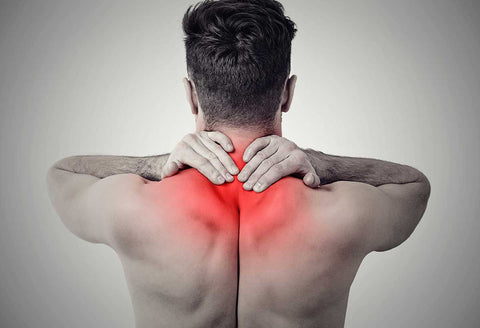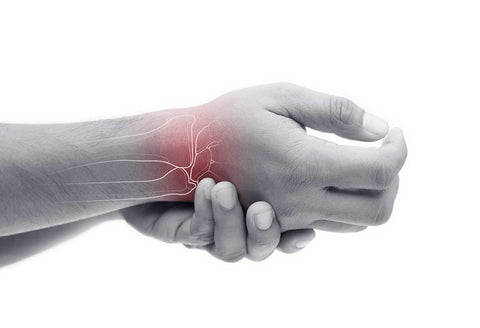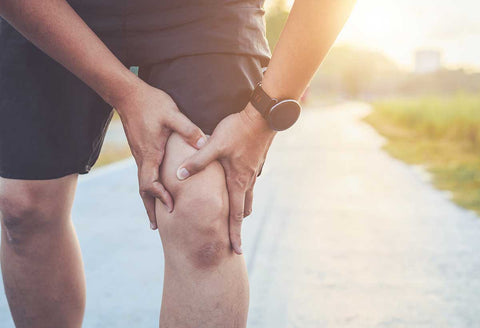10 Common Exercise Pains You Should Never Ignore

We all experience aches, pains, and soreness following a tough workout; it’s called delayed-onset muscle soreness or DOMS.
However, when the pain reaches a new level, you’re not able to use a muscle group, or the pain is centralized to one area, there may be a bigger problem that you need to address.
Let’s review the 10 common exercise pains you should never ignore. We’ll start at the top of the body and work our way down. We'll also discuss exercise equipment that can help to prevent pain during workouts.
For each of the following points, if you’re experiencing an extreme amount of muscular pain or if you’ve recently dropped a weight on yourself, get to a doctor immediately.
1. NECK PAIN
It doesn't take a lot to cause neck pain. Something as simple as a muscle strain can set it off. It can also occur from direct force trauma such as when you drop a barbell on yourself. A cervical spine injury can result in serious long-term consequences including chronic pain or even paralysis.
Prevention Tips: Master your form with overhead exercises and keep the weight light. Always use a spotter or a squat rack to catch the barbell. If you’re performing a barbell back squat, use a squat pad to cushion the neck.

2. SHOULDER PAIN
The shoulder plays an essential role in nearly all exercises. Overuse of the connective tissue can lead to a few strain-type shoulder injuries. If you have shoulder pain, you might have one of the following:
Rotator Cuff Tear: The rotator cuff is responsible for holding your upper arm bone in the socket. An eventual tear in the rotator cuff is common due to normal wear and use; however, repetitive exercises can quicken the time to injury.
SLAP Tear: The protective cartilage inside your shoulder socket can tear from overhead lifting or throwing. Taking a hit to the shoulder can also cause this.
Shoulder Impingement Syndrome: The connective tissue in the shoulder becomes inflamed from repetitive overhead lifting. This type of exercise is common in cross training workouts. The result is not being able to lift your arm above shoulder height.
Prevention Tips: It’s essential to make a habit of daily warm-ups and stretching sessions with a big focus on each head of the deltoid: front, side, and rear.
3. ELBOW PAIN
When you consistently perform exercises that focus a lot of impact and tension in the forearm and elbow, you risk developing lateral epicondylitis or tennis elbow.
Despite the name, tennis elbow is not limited to tennis players. It is the inflammation of the tendons and connective tissue in the forearm and elbow. Plenty of weightlifters, especially in CrossFit, develop this condition.
Prevention Tips: Be sure to properly warm-up and stretch the entire arm from your hands all the way to your shoulders. You can also place ice directly on the elbow after your workout. Cryotherapy and ice baths are excellent options for lowering inflammation.
4. WRIST PAIN
The wrist has a higher risk of injury from overuse, blunt trauma such as a weight falling down, and snapping exercises such as the clean-and-press. Overuse leads to inflammation and trauma can result in damaged tissue or ligaments.
Prevention Tips: Wrist support and injury prevention is a three-part process of stretching, strengthening, and using the right equipment. As often as you can, be sure to thoroughly stretch out your wrist and surrounding connective tissue. Start at the hands and work your way up. Once or twice a week, incorporate wrist exercises that increase strength such as the farmer’s walk and barbell forearm curls. Finally, wear protective gear such as wrist wraps.

5. STOMACH (ABDOMINAL) PAIN
If you’re a powerlifter or someone who lifts close to their one-repetition maximum on a consistent basis, listen up:
When you strain during an exercise, you put a lot of pressure on your abdominal wall. If you lack a strong core, you are at risk for developing a hernia. This is when a piece of your intestine pushes itself past the muscle tissue. Squats, deadlifts, and clean-and-presses are the most common exercises to put you at risk for a hernia.
Prevention Tips: You must strengthen your core. Don’t just focus on sit-ups. Take two or three days per week where you hit every angle of the core: front abdominal wall, obliques, and lower back. Weightlifting belts can also help because they provide a stable wall of support for the abdominal wall to push on during squats and deadlifts.
6. LOWER BACK PAIN
Lower back pain is the most common complaint in fitness. It can be the result of a simple pulled muscle or something as serious as a herniated disk.
A herniated disk occurs when one or several of the doughnut-like cushions that protect each vertebra in your spine bulge out and put pressure on surrounding nerves. Naturally, this is going to cause a lot of pain. Using too much weight and bad form during Olympic-based movements is typically to blame.
Prevention Tips: Hire a trainer for a month to watch and correct your form for compound movements such as the squat and deadlift. Gradually increase weight on a barbell – Don’t overdo it. If you suffer from a previous injury or surgery in your lower back, consider wearing a form of back support like a back brace.
7. SIDE LEG PAIN
If you are experiencing soreness and pain on the side of your leg, especially right above the knee, you may have iliotibial band syndrome. From your hip to your knee, you have a long stretch of connective tissue that is essential in leg exercises, especially lateral leg exercises. It can easily be overworked from a combination of weightlifting and plyometric (jump-based) exercises without proper recovery tactics such as stretching.
Prevention Tips: Stretching is essential to avoid IT band syndrome. Stretch your legs as a whole; don’t focus on only one part. Start at your feet and work your way up to your butt. Take extra time to perform lateral leg stretches to loosen the IT band. You can also wear some form of knee support like a sleeve or wrap during leg exercises.
8. KNEE PAIN
How often do you target your legs in the weight room? Are you using high-impact exercises such as jump squats? Are you feeling pain in your knee or just below the kneecap? If so, you may have developed patellar tendonitis. Common with CrossFitters or athletes who use jump training, this condition places the connective tissue and cartilage in the knee through a lot of stress and tension. Left unchecked, this inflammation can lead to strain and injury.
Prevention Tips: Just like many of the injuries above, the best method of prevention is to stretch and strengthen. Take time to fully stretch the lower body. You can also use ice on your knees for 10-minute intervals after a workout. If you have a history of knee issues, you may want to consider fitness equipment. A knee sleeve can be worn during normal workouts and a knee wrap during compound exercises such as the squat or deadlift.

9. ANKLE PAIN
Just like the wrist, the ankle is an essential point of stability and execution during most exercises. Given this, it’s very easy to be overused through excessive flexion and high-impact movements. Another way that you can hurt your ankle is by wearing the wrong footwear. If you have pain in your ankle that will not go away, you can may have developed Achilles tendonitis, or the inflammation of the tendon in the ankle.
Prevention Tips: First, it’s imperative that you make sure you’re wearing proper footwear. You can visit a podiatrist to have your feet measured and shoes prescribed. Next, be sure to take your ankle through a series of stretches before and after every workout. Ankle rolls work exceptionally well to loosen up this area.
10. EXTREME PAIN FOCUSED ON ONE MUSCLE GROUP
Finally, if you are experiencing an extreme amount of pain centralized in one muscle group that is accompanied by strange bruising, you may have rhabdomyolysis or rhabdo for short. This occurs when a muscle is pushed so far past its ability that the intensity of the exercise acts as a shock to the system. The result is the muscle is broken down and processed through the liver and kidneys, resulting in potential shock and hospitalization. This type is not something you see every day, but with high-intensity workouts, it’s becoming more common.
Prevention Tips: Be smart and responsible during your workouts. Do not push yourself to a point where you’re experiencing extreme pain. Go at a pace that is just outside your comfort level, not on the same level as a pro athlete.

